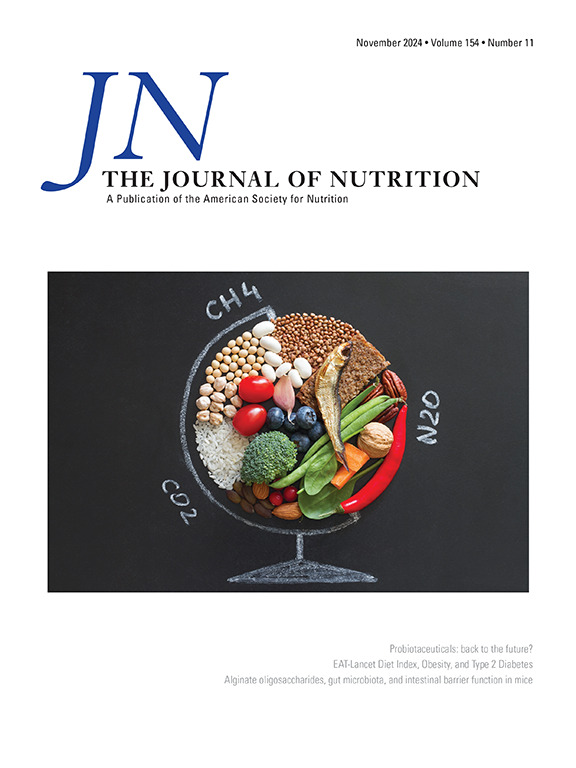Vitamin D Intakes of People Living in Canada: An Assessment Using Disaggregated Population Data from the 2015 Canadian Community Health Survey – Nutrition
IF 3.7
3区 医学
Q2 NUTRITION & DIETETICS
引用次数: 0
Abstract
Background
The dietary reference intakes for vitamin D were set in support of adequate vitamin D status. In Canada, the prevalence of inadequate vitamin D status is 19% based on biomarker data.
Objectives
The objectives of this study are to assess the adequacy of total usual intakes (UIs) of vitamin D of people living in Canada and explore sociodemographic correlates.
Methods
Vitamin D intake data from the 2015 Canadian Community Health Survey – Nutrition (n = 19,567, ≥1 y) were used. The prevalence of inadequate UI was defined as the percent below the estimated average requirement (%<EAR, 10 μg/d); risk of excess intakes was defined as the percent above the tolerable upper intake level (%>UL). Intakes (%<EAR and μg/d) of supplement users and nonusers were summarized by age–sex groups and sociodemographic factors. The top natural and fortified [mandated: cow’s milk and margarine; voluntary: plant-based beverages (PBBs)] food sources of vitamin D were explored.
Results
In supplement nonusers, %<EAR was ≥85.2% across age–sex groups. In supplement users (33.5%, 95% confidence interval: 32.1%, 34.8%), %<EAR ranged from 7.9% to 54.2% among age–sex groups. Overall, the %>UL was <3%. Total UI of vitamin D in supplement nonusers and users did not vary widely according to sociodemographic factors. Overall, the top 4 food sources of vitamin D were cow’s milk and fortified plant-based beverages (FPBBs) combined, margarine, fish, and eggs.
Conclusions
In Canada, the population prevalence of inadequate vitamin D intake is high, although lower among supplement users. Since the time of this survey, dietary guidance advises vitamin D supplementation for people ≥2 y who do not consume a daily food source of vitamin D. Subsequently, the amount of vitamin D in milks, margarines, and FPBB was increased and its addition to yogurts and kefirs was permitted. These strategies may help people living in Canada to achieve adequate intakes of vitamin D.
加拿大居民的维生素D摄入量:使用2015年加拿大社区健康调查-营养分类人口数据的评估
背景:维生素D的膳食参考摄入量是为了支持足够的维生素D状态而设定的。在加拿大,根据生物标志物数据,维生素D不足的患病率为19%。目的:本研究的目的是评估居住在加拿大的人的维生素D的总通常摄入量(UI)的充分性;并探索社会人口统计学的相关性。方法:使用2015年加拿大社区健康调查-营养(n=19,567,≥1年)的维生素D摄入数据。UI不足的发生率定义为低于估计平均需求(%UL)的百分比。结论:在加拿大,维生素D摄入不足的人群患病率很高,但在补充剂使用者中患病率较低。自本次调查以来,膳食指南建议年龄≥2岁且每日不摄入维生素D食物来源的人补充维生素D。随后,牛奶、人造黄油和FPBB中的维生素D含量增加,并允许在酸奶和酸奶中添加维生素D。这些策略可以帮助居住在加拿大的人们获得足够的维生素D摄入量。
本文章由计算机程序翻译,如有差异,请以英文原文为准。
求助全文
约1分钟内获得全文
求助全文
来源期刊

Journal of Nutrition
医学-营养学
CiteScore
7.60
自引率
4.80%
发文量
260
审稿时长
39 days
期刊介绍:
The Journal of Nutrition (JN/J Nutr) publishes peer-reviewed original research papers covering all aspects of experimental nutrition in humans and other animal species; special articles such as reviews and biographies of prominent nutrition scientists; and issues, opinions, and commentaries on controversial issues in nutrition. Supplements are frequently published to provide extended discussion of topics of special interest.
 求助内容:
求助内容: 应助结果提醒方式:
应助结果提醒方式:


